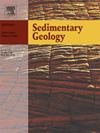Quantitative reconstruction of paleowind strength based on ancient marine longshore bars: A case study of the Pinghu Formation in Pingbei slope zone, Xihu Sag
IF 2.9
2区 地球科学
Q1 GEOLOGY
引用次数: 0
Abstract
Paleowind is an important paleoclimate parameter, but its study has been limited due to the lack of research methods. Recently, some researchers have proposed a method combining wind fields, waves, and the scale of ancient bar sand bodies to indirectly reconstruct paleowind. However, this method can only be used in lacustrine environments since in existing reconstruction methods, the fetch—a necessary parameter approximating the distance that wind blows—is difficult to obtain in marine environments. This study introduces the concept of “fully developed waves”, eliminating the need of fetch, which improves the current method of reconstructing paleowind using bars and extends its application to marine environments. The method is easy to operate and it only needs two parameters: the thickness of longshore bars and the seabed slope. This study further focuses on the bars of the Pinghu Formation in the Pingbei slope zone of the Xihu Sag within the East China Sea Shelf Basin. Using the proposed method, the paleowind variations during the depositional period (37.2–35.5 Ma) were reconstructed. The results show that the Xihu Sag was primarily influenced by easterly winds during this time, with wind speeds ranging from 8.76 to 19.71 m/s. This method removes the limitation of using bars for quantitative paleowind reconstruction exclusively in lacustrine settings, thereby enhancing its application potential and contributing to providing more data for paleoclimate reconstruction.
基于古海相滨岸坝的古风强度定量重建——以西湖凹陷平北斜坡带平湖组为例
古风是一个重要的古气候参数,但由于研究方法的缺乏,其研究一直受到限制。近年来,一些研究人员提出了一种结合风场、波浪和古坝砂体尺度的方法来间接重建古风场。然而,这种方法只能用于湖泊环境,因为在现有的重建方法中,很难在海洋环境中获得近似风吹距离的必要参数。该研究引入了“充分发育波”的概念,消除了提取的需要,改进了目前利用杆法重建古风的方法,并将其应用于海洋环境。该方法操作简单,只需要两个参数:岸坝厚度和海底坡度。本文进一步对东海陆架盆地西湖凹陷平北斜坡带平湖组砂坝进行了研究。利用该方法重建了沉积期(37.2 ~ 35.5 Ma)的古风变化。结果表明:该时期西湖凹陷以东风为主,风速范围为8.76 ~ 19.71 m/s;该方法消除了仅在湖泊环境下使用条形条进行定量古风重建的局限性,提高了其应用潜力,有助于为古气候重建提供更多的数据。
本文章由计算机程序翻译,如有差异,请以英文原文为准。
求助全文
约1分钟内获得全文
求助全文
来源期刊

Sedimentary Geology
地学-地质学
CiteScore
5.10
自引率
7.10%
发文量
133
审稿时长
32 days
期刊介绍:
Sedimentary Geology is a journal that rapidly publishes high quality, original research and review papers that cover all aspects of sediments and sedimentary rocks at all spatial and temporal scales. Submitted papers must make a significant contribution to the field of study and must place the research in a broad context, so that it is of interest to the diverse, international readership of the journal. Papers that are largely descriptive in nature, of limited scope or local geographical significance, or based on limited data will not be considered for publication.
 求助内容:
求助内容: 应助结果提醒方式:
应助结果提醒方式:


